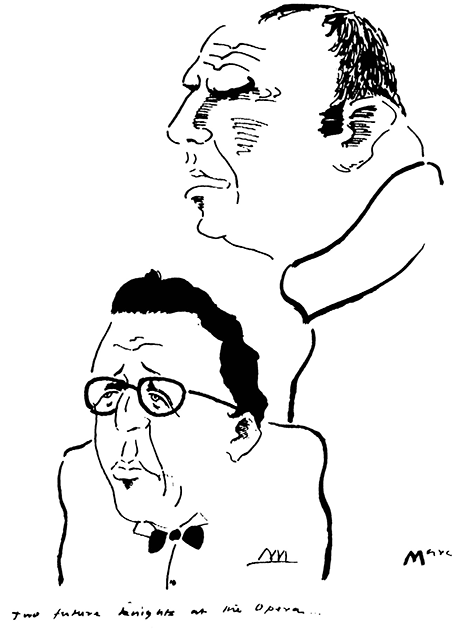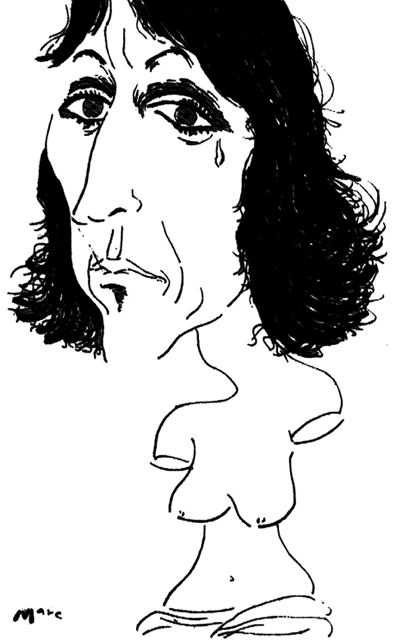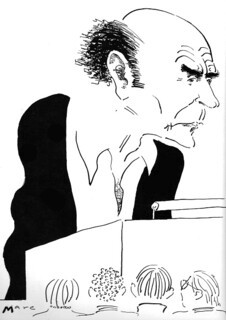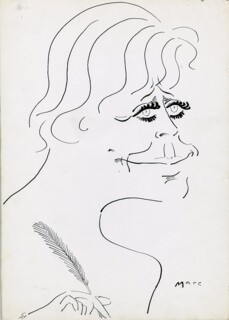Mark Boxer and the LRB
Inigo Thomas




Karl Miller liked to quote a passage from The Rime of the Ancient Mariner:
Like one, that on a lonesome road
Doth walk in fear and dread
And, having once turned round, walks on
And turns no more his head
Because he knows a frightful fiend
Doth close behind him tread.
The passage was much better, he'd add, if you changed a word in the penultimate line. Take out 'fiend', replace it with 'friend'.
Mark Boxer was a friend of Karl's; he was a friend of the LRB, too, and while he was no fiend, exactly, he was on the tail of his many friends, caricaturing them in his drawings, notalways to their liking. He was the first editor of the Sunday Times colour supplement, as such publications were called back in the day, but the drawings are the lasting achievement.
At the Cartoon Museum in Bloomsbury there's an exhibition of Boxer's work (until 22 March), includingsome of the cartoons that appeared in the early years of the London Review. A drawing of V.S. Naipaul appeared in the very first issue, looking like a yogi in knickers. Clive James wasdrawn by Boxer more than once, the first time with Bernard Levin (James was reviewing Levin's Taking Sides): 'Two Future Knights At the Opera' was Boxer's caption. He also drew F.R. Leavis (wearing a doublet), Anthony Powell, Margaret Drabble, Ted Hughes, Barbara Castle, Graham Greene, Seamus Heaney, Germaine Greer as the Venus de Milo.
Most of Boxer's drawings for the LRB were without captions, but as the show points out words appeared as frequently on the cartoons as not, typed by Boxer: 'Back in the Sixties, HuwWheldon discovered these significant holes in the schedules. And when hot air was pumped into them it was discovered this space turned out to be occupied by the brilliant polymath Jonathan Miller.'A cartoon published by the Telegraph in 1987, shortly before that year's general election reads. 'I read this very Tory manifesto but it appears to be put out by the Labour party.'
The strip-cartoon Life and Times in NW1 featured Simon and Joanna String-Along, upper-middle-class media people in Camden Town based on characters in Alan Bennett's 1966 series On the Margin. The cartoon began at the Listener in 1967; two years later it emigrated to the Times. One of the strips goes like this:
Simon: Have you seen this scheme to route the Stansted extension slap through NW1.
Joanna: What a marvellous opportunity for a really valid protest movement. Moira can do a TV programme; we can have a party; and the Touch-Paceys can design a protest button.
Simon: I'm just going up to your den to draft a letter to the Times. We'll have some genuinely distinguished signatures for a change. In fact it's my great opportunity to be listed under that magical cross-heading 'from Professor Ayer and others'.
Moira: Congratulations. I've just heard from the residents' committee that the developers are going to make you a huge offer for your home.'
Simon: Perhaps we've been rather hasty. I was beginning to feel dubious about aligning ourselves with the Betjemanites against the irresistible force of an unmovable trend.
The first image at the Cartoon Gallery isn't one of Boxer's cartoon's but extracts from a documentary about his life and times; he was interviewed by Francis Hope. Good-looking would be one way to describe Mark Boxer; very good-looking would be another. He also had a lot of friends, as Frank Kermode wrote in the LRB in 1994:
It sometimes happens that an exceptionally talented person dies rather young, leaving behind him friends, still in their prime, who happen to be good writers – witness the posthumous celebrationsof Shelley and D.H. Lawrence. Mark Boxer was famous at Cambridge; he was even famous for the manner of his leaving it; and then, without serious intermission, he became and remained famous inLondon. And so, throughout his life, he was unwittingly acquiring eulogists.
'TV is a licence to stare,' Boxer tells Hope. He prefers to go to parties, he says, 'pick-up places' where he captures 'certain words and phrases, the details of clothes'. Glasses of wine, cigarettes, ties and the way they are tied are features of Boxer's cartoons; his subjects' eyes are often frighteningly close together. Asked about his fears or nightmares, Boxer tells Hope about adream that terrifies him: he's floating above people at cocktail parties. But then he concedes this is 'quite a nice feeling, like walking on water'. Which in a way gets to Boxer's two-mindedness; the wanting to be there, but to be seen apart; the wanting to be seen as outstanding so as to be all the more there, at the heart of where the action is.
Comments